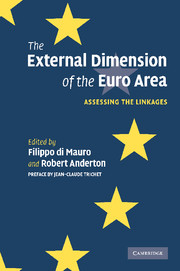Book contents
- Frontmatter
- Contents
- List of illustrations
- List of contributors
- Preface by Jean-Claude Trichet
- 1 Introduction
- 2 The external dimension of the euro area: stylised facts and initial findings
- 3 Product variety and macro trade models: implications for the new EU Member States
- 4 Exchange-rate pass-through to import prices in the euro area
- 5 The international equity holdings of euro area investors
- 6 Global linkages through foreign direct investment
- 7 Shocks and shock absorbers: the international propagation of equity market shocks and the design of appropriate policy responses
- 8 The euro area in the global economy: its sensitivity to the international environment and its influence on global economic developments
- Index
Preface by Jean-Claude Trichet
Published online by Cambridge University Press: 22 September 2009
- Frontmatter
- Contents
- List of illustrations
- List of contributors
- Preface by Jean-Claude Trichet
- 1 Introduction
- 2 The external dimension of the euro area: stylised facts and initial findings
- 3 Product variety and macro trade models: implications for the new EU Member States
- 4 Exchange-rate pass-through to import prices in the euro area
- 5 The international equity holdings of euro area investors
- 6 Global linkages through foreign direct investment
- 7 Shocks and shock absorbers: the international propagation of equity market shocks and the design of appropriate policy responses
- 8 The euro area in the global economy: its sensitivity to the international environment and its influence on global economic developments
- Index
Summary
Although relatively closed in comparison with the individual constituent countries, the euro area economy is subject to a broad range of economic impacts originating from outside its borders, by an extent which remains significant. At the ECB we are well aware of the international linkages of the euro area and in 2004, we hosted a workshop on ‘The Importance of the External Dimension for the Euro Area: Trade, Capital Flows and International Macroeconomic Linkages’. Drawing partly from that workshop and using the most recent research, the book edited by di Mauro and Anderton aims at providing an overall understanding of how and to what extent external developments affect the euro area. Using a broad range of methodologies and techniques, the chapters bring together the latest information and results regarding the various channels connecting the euro area to its external environment, most notably the trade, capital flows and other international macroeconomic linkages.
The work is ambitious as it attempts to tackle a number of complex, overarching issues: how good are standard openness measures to ascertain the impact of trade developments on the euro area economy; what are the most relevant economic linkages between the euro area and the rest of the world; what are the channels and mechanisms by which the euro area is influenced by external developments and how are they changing through time; and what can we say regarding claims that there has been an increase in the international synchronisation of economic cycles?
- Type
- Chapter
- Information
- The External Dimension of the Euro AreaAssessing the Linkages, pp. xiii - xivPublisher: Cambridge University PressPrint publication year: 2007
- 4
- Cited by

